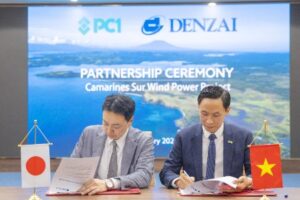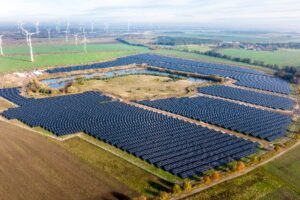Wind Farms Definition: Their Purpose and Impact

Wind farms consist today in a group of large wind turbines installed in an area where the wind has enough potential to generate electricity day and night.
Wind farms can be installed onshore and the land between them can be used for agriculture, or offshore (not very far from the shore) because the winds are stronger there due to the lack of natural or man-made obstacles (large trees, hills, mountains, buildings, etc.).
Wind farms definition explained.
What Are Wind Farms?
Wind farms represent today a small or a large group of wind turbines installed in an area where the wind is strong enough and steady to generate clean electricity almost all the time.
Many of the land operating wind farms (onshore wind farms) are located today in Asia (China and India are hosting today some of the largest onshore wind farms on the planet) and in the U.S., while Europe hosts the biggest offshore wind farm in the world (London Array in the UK).
Wind Farm Location and Design
Modern wind turbines start operating when the speed of the wind reaches 7 mph (11 km/h) and beyond, but not more than 55 mph (88 km/h) for safety reasons.
The ideal speed of the wind needs to be between 7 and 16 mph (11 and 26 km/h) for the wind turbine to work properly in safe conditions.
Any speeds bellow this range will not even start the turbine, and any speed above the range and up to 55 mph will generate more power, but will overload the turbine.
The selected area for the construction of a new wind farm needs to provide steady winds with speeds of over 7 mph, but bellow 55 mph, throughout the year.
A wind project represents a major investment, which means that the area selected for the construction of the new wind farm will be first screened using a wind atlas (contains data regarding the speed and the direction of the wind in a region), and will be validated using wind measurements over a period of one year or more.
The entire project will receive the green light only if the measurements will prove that the winds in that area are suited for the construction of the wind farm.
The wind turbines will be installed pretty close to each other (on land) because spreading the wind turbines on a large area (at a great distance between them) will increase the investment with the price paid for extra land, more roads, more cables and so on.
Manufacturers require a minimum distance between turbines of 3.5 times the diameter of the rotor, which means that the land occupied by a wind farm does not need to be extremely large.
Onshore Wind Farms
Onshore wind farms (land wind farms) are the first wind farms built for electricity generation (offshore wind farms being built way more recently).
Today, some of the largest onshore wind farms are located in Asia (countries like China and India), in the U.S. and in Europe (Romania hosts the largest onshore wind farm in Europe).
List of the largest onshore wind farms in the world today (installed capacity of at least 1,000 MW)
- 1. Gansu Wind Farm in China, with an installed capacity of 6,800 MW.
- 2. Zhang Jiakou Wind Farm in China, with a generation capacity of 3,000 MW.
- 3. Urat Zhongqi, Bayannur City Wind Power Plant in China, has an installed capacity of 2100 MW.
- 4. Hami Wind Farm in China, installed capacity of 2,000 MW.
- 5. Damao Qi, Baotou City Wind Power Plant in China, with an output of 1600 MW.
- 6. Alta (Oak Creek-Mojave) Wind Farm in the U.S. with an installed capacity of 1320 MW.
- 7. Jaisalmer Wind Power Plant in India, with a generation capacity of 1,064 MW.
- 8. Hongshagang, Town, Minqin County Wind Farm in China, with an output of 1,000 MW.
- 9. Kailu, Tongliao Wind Power Plant in China, has an installed capacity of 1,000 MW.
- 10. Chengde Wind Power Plant in China, with an output of 1,000 MW.
Offshore Wind Farms
If Asia and the U.S. are world leaders today in wind power generation onshore, Europe is the world leader in wind power generation offshore.
The first offshore wind farm in Europe was installed in 1991 in Denmark (Vindeby Offshore Wind Farm).
By 2010, Europe already had a number of 39 offshore wind farms installed in countries like Denmark, Belgium, Finland, the Netherlands, Ireland, Germany, the UK, Sweden and Norway and with a combined output of 2,396 MW (2,39 GW).
WindEurope has already set a target of 40 GW (40,000 MW) offshore wind capacity installed by 2020 and 150 GW (150,000 MW) by 2030.
Since 2017, the UK hosts the largest offshore wind farm in the world (the London Array), with an installed capacity of 630 MW.
The second largest offshore wind farm on the planet is the Gemini Wind Farm in the Netherlands, with an installed capacity of 600 MW.
List of the largest offshore wind farms in the world (installed capacity of at least 300 MW)
- 1. London Array in the UK, with an installed capacity of 630 MW.
- 2. Gemini Wind Farm in the Netherlands, with a generation capacity of 600 MW.
- 3. Greater Gabbard Wind Farm in the UK, has an installed capacity of 504 MW.
- 4. Anholt Offshore Wind Farm in Denmark, installed capacity of 400 MW.
- 5. BARD Offshore 1 in Germany, with an output of 400 MW.
- 6. Rampion Wind Farm in the UK with an installed capacity of 400 MW.
- 7. Walney Offshore Wind Farm in the UK, with a generation capacity of 367 MW.
- 8. Thorntonbank Offshore Wind Farm in Belgium, with an output of 325 MW.
- 9. Sheringham Shoal Offshore Wind Farm in the UK, has an installed capacity of 315 MW.
- 10. Thanet Offshore Wind Farm in the UK, with an output of 300 MW.
The first offshore wind farm in the U.S. is the Block Island Wind Farm located near Block Island (Rhode Island) in the Atlantic Ocean, with a generation capacity of 30 MW.
Canada is also interested to build offshore wind farms in several locations in the Great Lakes, but also on the Pacific west coast.
Offshore wind farms have a reduced impact on the landscape because being located a few miles offshore they are less obtrusive compared to the wind turbines installed on the land.
Also the noise produced by the rotating turbines cannot be heard from such a distance.
Environmental Impact of Wind Power
Wind farms have a very reduced impact on the environment if we compare them with the power plants burning fossil fuels for energy generation.
Wind farms produce clean electricity and no harmful emissions.
Some birds or bats can be affected by the rotating blades of the turbines, but this situation cannot be compared with the billions of people affected by the massive air pollution produced by the power plants burning coal, oil and natural gas for energy production.
Using the kinetic power of the wind (a renewable resource) to produce clean electricity, onshore and offshore wind farms have more advantages than disadvantages.
Being considered a renewable energy source (a never ending source of clean power), wind energy represents an energy source of the future, where along with the other sources of clean power (solar, geothermal, hydro, tidal, wave, nuclear fusion, biomass etc.) will replace the dirty fossil fuels in terms of energy generation.
Effects of Wind Farms on the Power Grid
Wind energy is an intermittent source of electricity, which means that the energy produced by the wind farms cannot be used alone to power the grid.
Usually, the clean electricity produced by the wind farm is sent into the grid where is combined with electricity produced by a low-carbon energy source (a power plant burning natural gas) to provide a constant supply of electricity in the grid.
During the day, we can get from the grid only clean electricity produced by the wind farm (when the wind farm has a good production and the demand is low in the grid).
However, when the demand is high, we can receive from the grid electricity produced from both sources: wind (which is clean) and fossil fuels (which is dirty).
Final Conclusion
Wind power cannot take its place among the main sources of energy on the planet without a massive development of the generation capacity, which means way more wind projects to become operational all over the planet.






